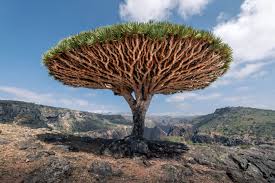Socotra , Yemen
🌴 Socotra: The Island of Unique Wonders
"A paradise unlike any other, where alien landscapes, extraordinary biodiversity, and stunning beaches await."
🏝️ About Socotra
Socotra is a remote archipelago in the Arabian Sea, often described as one of the most isolated and biologically unique places on Earth. Known for its otherworldly landscapes, rare flora, and pristine beaches, Socotra has earned the nickname "the Galápagos of the Indian Ocean" due to its exceptional biodiversity.
Part of Yemen, Socotra consists of four islands — Socotra, Abd al-Kuri, Samha, and Darsa — with Socotra Island being the largest and most well-known. The island’s ecosystems have evolved in isolation, resulting in the development of endemic species that can’t be found anywhere else in the world.
✔️ UNESCO World Heritage Site
✔️ Known for its unique biodiversity
✔️ Home to the iconic Dragon Blood Trees
✔️ Stunning beaches, lagoons, and mountainous terrain
🌿 Top Things to See in Socotra
🌳 Dragon Blood Tree Forests
The Dragon Blood Tree is perhaps the most famous feature of Socotra. These iconic trees have umbrella-shaped canopies and red sap, which gives the trees their name. They are a symbol of the island’s unique flora and have been used for centuries in traditional medicine and dyes.
-
Where to see them: The Haghier Mountains are home to the largest concentration of Dragon Blood Trees.
🌊 Detwah Lagoon
One of Socotra’s most beautiful spots, Detwah Lagoon is a pristine, crescent-shaped bay with turquoise waters and surrounding sandbars. It is an ideal spot for swimming, kayaking, and simply relaxing in an unspoiled natural setting.
-
Fun Fact: The lagoon is a perfect place for birdwatching, with numerous migratory bird species visiting throughout the year.
🏖️ Qalansiyah Beach
Known for its crystal-clear waters and white sandy beaches, Qalansiyah Beach is a serene spot for relaxation. Surrounded by dramatic cliffs and rocky hills, it offers a stunning view of the Arabian Sea and is a great place to unwind after exploring the island.
-
Activities: Snorkeling, swimming, and sunbathing.
🏔️ The Haghier Mountains
The Haghier Mountains rise to over 1,500 meters (5,000 feet) and offer dramatic views of the island and surrounding waters. Hiking in this area allows visitors to experience traditional villages, breathtaking views, and unique flora and fauna endemic to Socotra.
-
Hiking Tip: The mountain trails are not well-marked, so consider hiring a local guide for a safe and informative trek.
🐉 The Hoq Cave
The Hoq Cave is a fascinating natural wonder, known for its stalactites and stalagmites. It is an essential stop for adventurous travelers looking to explore the island's hidden gems.
-
Pro Tip: Bring a flashlight to explore the cave’s intricate interior!
🎟️ Visitor Information
-
Location: Socotra Archipelago, Yemen (located about 350 km from the Arabian Peninsula)
-
Population: Around 50,000
-
Best Time to Visit: October to April, as the weather is milder and more suitable for outdoor activities.
-
Travel Tips: Due to its remote location, traveling to Socotra requires planning. Flights typically depart from Aden or Sana’a. Socotra’s infrastructure is limited, so visitors should be prepared for a rustic experience.
🚗 How to Get There
-
By Air: Socotra International Airport is the main entry point, with flights from Aden or Sana’a in mainland Yemen.
-
By Sea: There are occasional cargo ships that dock in Socotra, but this option is less common for travelers.
🌟 Fun Facts About Socotra
-
Unique Biodiversity: Socotra is home to over 300 species of flora and 200 species of fauna that are found nowhere else on Earth. This includes the Dragon Blood Tree, Socotra Cormorant, and Socotra Starling.
-
Unusual Landscape: Socotra’s landscape is unlike anywhere else, with rocky cliffs, sand dunes, tropical forests, and desert plains all existing side by side.
-
Ancient Trade: Socotra has been an important trade hub for centuries, particularly for frankincense, myrrh, and dragon’s blood resin, which were highly prized in ancient Egypt and beyond.
✨ Why Visit Socotra?
Socotra is an off-the-beaten-path destination for those looking to explore untouched nature, remote islands, and unique cultures. Its stunning landscapes, breathtaking beaches, and rare wildlife make it a paradise for nature lovers, adventure travelers, and those seeking an unusual and serene escape from the more touristy destinations.
📅 Best Time to Visit
-
Autumn (October-November): The weather is still warm, but the island is less crowded than in the peak months.
-
Winter (December-February): The best time for hiking and exploring the Haghier Mountains.
-
Spring (March-May): A great time for snorkeling and swimming, as the waters are clear and warm.
🌴 Discover the Hidden Paradise of Socotra
Step into the breathtaking landscapes of Socotra, a land where the alien-like trees, deserted beaches, and clear waters will make you feel like you’ve stepped into another world. Whether you’re an adventurer, nature enthusiast, or just someone seeking solitude in paradise, Socotra is a destination unlike any other.
📸 Travel Tip: Don’t forget to capture the iconic Dragon Blood Trees at sunset, when their shadows create dramatic, ethereal shapes against the sky!


